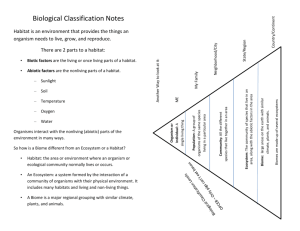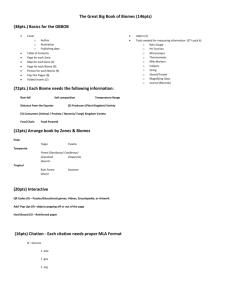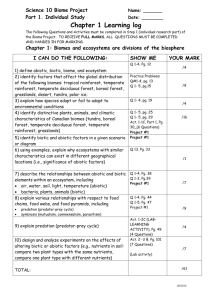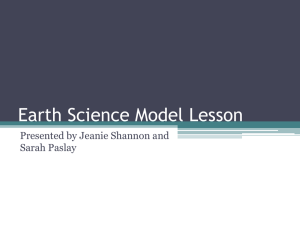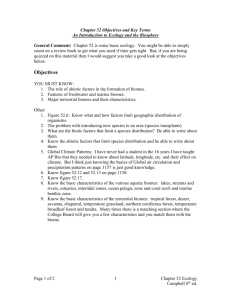General Review for the Quiz
advertisement
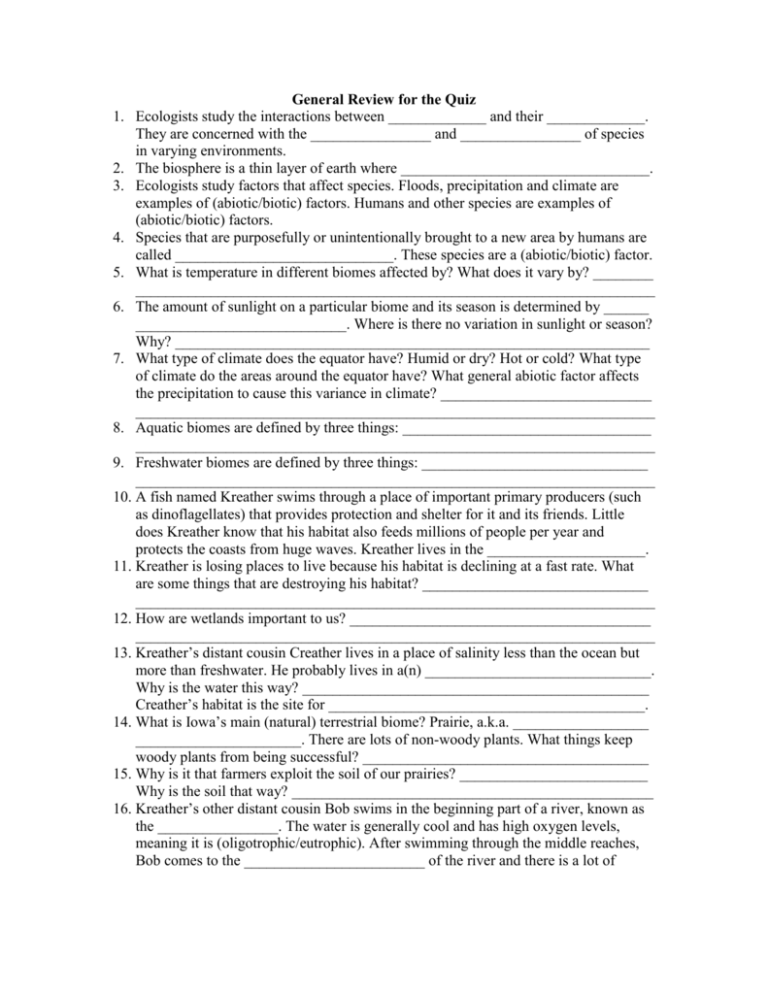
General Review for the Quiz 1. Ecologists study the interactions between _____________ and their _____________. They are concerned with the ________________ and ________________ of species in varying environments. 2. The biosphere is a thin layer of earth where _________________________________. 3. Ecologists study factors that affect species. Floods, precipitation and climate are examples of (abiotic/biotic) factors. Humans and other species are examples of (abiotic/biotic) factors. 4. Species that are purposefully or unintentionally brought to a new area by humans are called _____________________________. These species are a (abiotic/biotic) factor. 5. What is temperature in different biomes affected by? What does it vary by? ________ _____________________________________________________________________ 6. The amount of sunlight on a particular biome and its season is determined by ______ ____________________________. Where is there no variation in sunlight or season? Why? _______________________________________________________________ 7. What type of climate does the equator have? Humid or dry? Hot or cold? What type of climate do the areas around the equator have? What general abiotic factor affects the precipitation to cause this variance in climate? ____________________________ _____________________________________________________________________ 8. Aquatic biomes are defined by three things: _________________________________ _____________________________________________________________________ 9. Freshwater biomes are defined by three things: ______________________________ _____________________________________________________________________ 10. A fish named Kreather swims through a place of important primary producers (such as dinoflagellates) that provides protection and shelter for it and its friends. Little does Kreather know that his habitat also feeds millions of people per year and protects the coasts from huge waves. Kreather lives in the _____________________. 11. Kreather is losing places to live because his habitat is declining at a fast rate. What are some things that are destroying his habitat? ______________________________ _____________________________________________________________________ 12. How are wetlands important to us? ________________________________________ _____________________________________________________________________ 13. Kreather’s distant cousin Creather lives in a place of salinity less than the ocean but more than freshwater. He probably lives in a(n) ______________________________. Why is the water this way? ______________________________________________ Creather’s habitat is the site for __________________________________________. 14. What is Iowa’s main (natural) terrestrial biome? Prairie, a.k.a. __________________ ______________________. There are lots of non-woody plants. What things keep woody plants from being successful? ______________________________________ 15. Why is it that farmers exploit the soil of our prairies? _________________________ Why is the soil that way? ________________________________________________ 16. Kreather’s other distant cousin Bob swims in the beginning part of a river, known as the ________________. The water is generally cool and has high oxygen levels, meaning it is (oligotrophic/eutrophic). After swimming through the middle reaches, Bob comes to the ________________________ of the river and there is a lot of sedimentation. The sediment holds decaying things in water, meaning there is less oxygen and thus (oligotrophic/eutrophic). 17. What are the three ways that humans have impacted Iowa’s rivers? ______________ _____________________________________________________________________ How does this affect this aquatic biome? ___________________________________ _____________________________________________________________________ 18. What are the 5 population attributes that we study? ___________________________ _____________________________________________________________________ 19. Kelly Scientist wants to count the population size of buffalo. She attempts a census, but finds it near impossible to count each one (could YOU tell them apart?). She could _______________________________________________________________. 20. The _______________ of a species—or number of individuals per unit area—affects what? _______________________________________________________________ 21. Kelly notices that buffalo exist in clumped distributions. What does this suggest about the buffalo? They have (positive/neutral/negative) interactions, such as____________ _____________________________________________________________________ 22. Kelly notices that wild turkeys exist in uniform distributions. What does this suggest about them? They have (positive/neutral/negative) interactions, such as____________ _____________________________________________________________________ 23. Kelly notices that weeds exist in random distributions. What does this suggest about the weeds? They have (positive/neutral/negative) interactions, such as_____________ _____________________________________________________________________ 24. Demography studies the factors that affect __________________________________. One particular factor is the sex ratio of a population. For humans, the (secondary/primary) sex ratio is 50:50 to indicate the number of (newborn/adult) girls to guys. The (secondary/primary) sex ratio is not 50:50 due to many factors affecting the (newborn/adult) population. 25. Another factor of demography is age structure. Kelly notices that for a prairie beetle all adults die before the next generation of beetles are born, demonstrating _______________________ generations. For a prairie plant, many different ages of plants exist at one time, demonstrating _______________________ generations.



